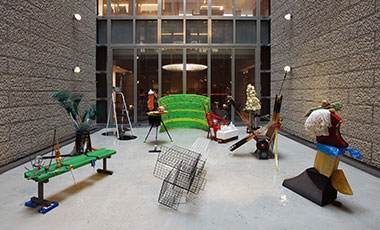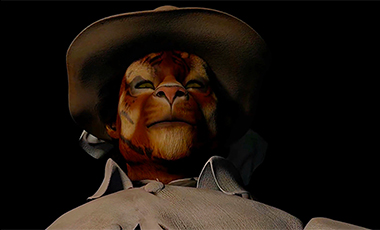

Kim Tschang-yeul's 〈Waterdrops〉 (2015) is on view at 《Empty Fullness: Materiality and Spirituality in Contemporary Korean Art》 exhibit organized by Chung Joon-mo at Park Ryu Sook Gallery in central Seoul through May 10. Courtesy of the artist and Park Ryu Sook Gallery
《Empty Fullness: Materiality and Spirituality in Contemporary Korean Art》, an exhibition at Park Ryu Sook Gallery in Itaewon, Seoul, redefines and broadens aspects of Korean monotone painting.
Chung Joon-mo, former curatorial director at the National Museum of Modern and Contemporary Art, organized this exhibition which has been traveling across the globe since 2014.
"Everyone talks about Dansaekhwa, but it was more brainwashing without properly studying what Dansaekhwa is. Korean monotone painting represents the sentiment of Korean art the best by far and I wanted to reshape the aesthetic framing on Korean monotone painting," Chung said. "Many art exhibits in Korea are like select shops, featuring popular or famous artists. A good art exhibition needs to be set in a context."
Though Chung is one of the pioneers among art theorists who rediscovered the Dansaekhwa (Korean monochrome painting) trend, Chung opposes the term and uses Dansaekjo Hoehwa, which refers to Korean monotone painting, instead.
Chung said Dansaekhwa is a translation of Western art term monochrome and Korean monotone painting is more about the process than its color. While Western monochrome painting is inherited from minimal art, Korean monotone painting is more about spiritual quality and is non-rational.
"Korean Monotone Painting is like a moon jar, which looks empty but full of Korea's artistic value such as the beauty of space, contemplation and movement in stillness. As the artist repeats action and layers of time piled up on one another, the painting takes shape. Korean Monotone Painting is the art of the process," Chung explained.

Atta Kim's 〈ON-AIR Project ― Analects of Confucius〉 (2010/14) / Courtesy of the artist and Park Ryu Sook Gallery
As part of theKorea Arts Management Service's "Traveling Korean Arts" program, the exhibit toured to Shanghai and Beijing, China; Berlin, Germany; Jakarta, Indonesia; Sao Paulo, Brazil; Hong Kong; Buenos Aires, Argentina; Teheran, Iran; and Hanoi, Vietnam.
"Each country reacted differently based on their culture. In China and Vietnam, both countries used to practice socialist realism art, asked where the painting is. However, the exhibit was popular beyond expectations in Argentina," Chung recalled.
Only a handful of artists who were active since the 1970s are typically noted as the Dansaekhwa group, but Chung's selection is much broader, including photographers Atta Kim and Lee Jin-young and ceramic artist Kwon Dae-sup.
The 18 artists featured in this exhibit all traveled around the world with this exhibit.
"When I become interested in an artist's work, I usually go visit the artist's studio to see how they actually create it," Chung said, emphasizing the importance of process. "Korean monotone painting is all about repetition, superposition and overlay. It doesn't have to be traditional painting."
The exhibit does not neglect known masters of Korean monotone painting including Yun Hyong-keun, Chung Chang-sup, Park Seo-bo, Chung Sang-hwa and Kim Tschang-yeul with an addition of prominent artists Khang Young-soon, Kim Keun-tai and Nam Tshun-mo and younger generation artists of Kim Deok-han and Yoon Sang-yuel.

Kwon Dae-sup's 〈Moon Jar〉 / Courtesy of the artist and Park Ryu Sook Gallery
Kwon Dae-sup's moon jar graces the gallery space with its refined presence. According to Chung, the moon jar looks perfectly round from afar, but crooked and lopsided when looked at up close and such characteristics represent Korean art history and aesthetics.
Chung said Atta Kim's 〈ON-AIR〉 project can be Korean monotone art as he printed layers of photographs on sensitized paper. Another photographer Lee Jin-young also creates abstract photographic images on "hanji" (Korean mulberry paper) using ambrotype photographic technique.
Choi Sang-chul minimizes the artist's intervention to his work by throwing objects such as stone and thread, coated in paint, at a canvas thousands of times and records the traces the objects leave. Kim Taek-sang's 〈Breathing Light〉 series is created by dipping the canvas fabric into colored water multiple times, which could take up to two years to complete a piece.
Kim Deok-han's 〈Overlaid〉 series employs "ottchil," or Korean traditional lacquering method, to present layers of different colors on a panel. Lee Jin-woo puts hanji paper on charcoal and taps them with a metallic brush strenuously and repetitively until their materiality transforms.

Kim Deok-han's 〈Overlaid Series No. 1912〉 (2019) / Courtesy of the artist and Park Ryu Sook Gallery
Though varied in medium and process, what they all have in common is that there is unseen intensive labor behind the final product as the artist puts in endless effort and thought.
With more artists already in his list of Korean monotone painting, Chung plans to expand the exhibition later this year.
"This returning exhibit in Seoul is going to be a chance to brace up for me. I will reorganize it and apply for more overseas exhibitions later this year in cooperation with Korean Cultural Centers in Europe," Chung said.
"Korean monotone painting is diverse in technique. I am working on a book tentatively titled 'Korean Dansaekjo Hoehwa Is Not Achromatic.'"
The exhibit runs through May 10.
※ This article was originally published in The Korea Times on 12 April 2020, and reposted under authority of The Korea Times.
※ Click to Read the Original Article: https://www.koreatimes.co.kr/www/culture/2020/04/145_287767.html



